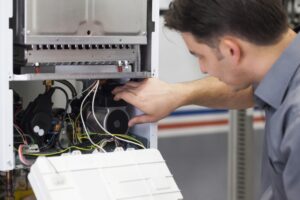Have you started up your furnace yet this fall? If you haven’t, you’ll be doing it soon. And this is the perfect time for a little refresher course in how to keep your gas furnace happy. Annual maintenance is important, of course. But once you have that done, you should also keep an eye (or an ear) out for any problems.
Knowing the signs of common furnace issues can save you considerable time and money and help you steer clear of major inconvenience. Detecting gas furnace problems as promptly as possible helps you keep repairs small and avoid having a total breakdown in cold weather.
Shutting Down
If your gas furnace turns off as soon as it turns on, that’s probably the limit switch shutting the system down for safety, which is generally a response to overheating. Try changing the air filter to help with airflow, but if the problem continues, you need professional repairs. Chances are, you’ve either got an overheating component or a failing limit switch.
Noises
Whoosh-boom like a gas grill starting? There’s a delay in igniting the gas, perhaps because of the ignition system or the flame sensor. Clickety-rattle? With luck, it’s just a loose part clattering with the vibration, but it could be a cracked heat exchanger. Either of these issues can be dangerous if they continue, so get furnace repair in Evanston, IL right away.
Rotten Eggs
Aside from a brief hot-dust smell when you first start your furnace up in fall, it shouldn’t cause any odors. In fact, natural gas itself has no odor. For your safety, mercaptan is added to give gas its distinctive nasty smell. If you smell sulfur, like rotten eggs, you’ve got a gas leak. Get out of the house and contact your gas company’s emergency line, or 911 if you can’t get through there.
Puddles
No, water is not part of your gas furnace’s heating system. But condensation is a natural byproduct of it. It should be going down a drain, and puddles can indicate that the condensate line is clogged. A technician can get it cleaned out for you and provide tips on how to keep this problem from happening again.
Strange Colors
Your gas furnace’s flame should only ever burn blue. Any other color indicates a major problem, usually incomplete combustion of the natural gas. So if you see yellow or orange instead of blue, get repairs right away. It may just be that the burner is dirty or clogged, but you could have a cracked heat exchanger or damage to your gas line.
Electrical Issues
Yes, even gas furnaces do use electricity. If you notice that lights in your home flicker when your furnace comes on, or you hear a buzzing sound, your gas furnace could be experiencing electrical issues. For your safety, don’t tinker with it! Rely on qualified professionals to make the necessary repairs.
Keep an eye—and an ear—out for these warning signs, so you can get the help you need right away.
Contact ServiceMax with any questions about your heating system.
